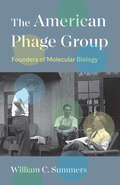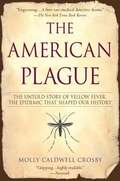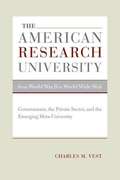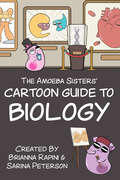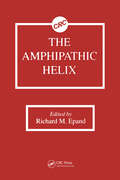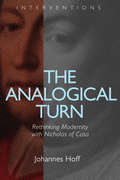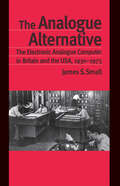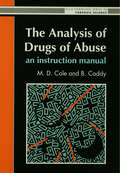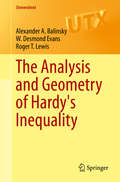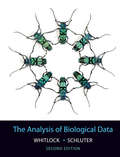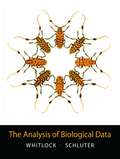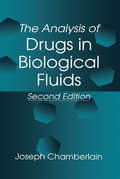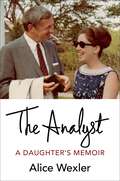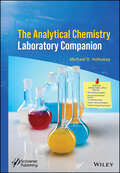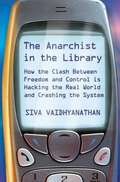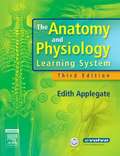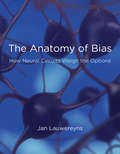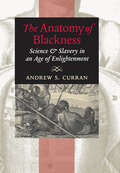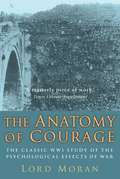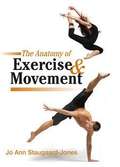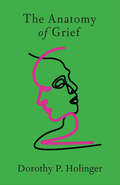- Table View
- List View
The American Phage Group: Founders of Molecular Biology
by William C. SummersA fascinating historical account of the American Phage Group and how its new research framework became the foundation for molecular biology This book is the first critical and analytical study of the American Phage Group—a small group of scientists who gathered around Max Delbrück, Salvador Luria, and Alfred Hershey between 1940 and 1960—and how this novel research program became the foundation of the field of molecular biology. These three young, charismatic, and iconoclastic scientists were convinced of the importance of bacterial viruses (bacteriophages) to the study of the gene and of heredity in general. Based on substantial archival research, numerous participant interviews collected over the past thirty years, and an intimate knowledge of the relevant scientific literature in the field, William C. Summers has written a fascinating new history of the American Phage Group. Rather than a linear narrative of progress by past heroes, this book emphasizes the diversity and historical contingencies in the group’s development.
The American Plague
by Molly Caldwell CrosbyIn this account, a journalist traces the course of yellow fever, stopping in 1878 Memphis to "vividly [evoke] the Faulkner-meets-'Dawn of the Dead' horrors,"*-and moving on to today's strain of the killer virus. Over the course of history, yellow fever has paralyzed governments, halted commerce, quarantined cities, moved the U.S. capital, and altered the outcome of wars. During a single summer in Memphis alone, it cost more lives than the Chicago fire, the San Francisco earthquake, and the Johnstown flood combined. In 1900, the U.S. sent three doctors to Cuba to discover how yellow fever was spread. There, they launched one of history's most controversial human studies. Compelling and terrifying, The American Plague depicts the story of yellow fever and its reign in this country-and in Africa, where even today it strikes thousands every year. With "arresting tales of heroism,"** it is a story as much about the nature of human beings as it is about the nature of disease.
The American Plague
by Molly Caldwell CrosbyIn this account, a journalist traces the course of yellow fever, stopping in 1878 Memphis to "vividly [evoke] the Faulkner-meets-'Dawn of the Dead' horrors,"*-and moving on to today's strain of the killer virus. Over the course of history, yellow fever has paralyzed governments, halted commerce, quarantined cities, moved the U.S. capital, and altered the outcome of wars. During a single summer in Memphis alone, it cost more lives than the Chicago fire, the San Francisco earthquake, and the Johnstown flood combined. In 1900, the U.S. sent three doctors to Cuba to discover how yellow fever was spread. There, they launched one of history's most controversial human studies. Compelling and terrifying, The American Plague depicts the story of yellow fever and its reign in this country-and in Africa, where even today it strikes thousands every year. With "arresting tales of heroism,"** it is a story as much about the nature of human beings as it is about the nature of disease.
The American Research University from World War II to World Wide Web: Governments, the Private Sector, and the Emerging Meta-University
by Charles M. VestThis volume provides a unique opportunity to explore the current state of the research university system. Charles M. Vest offers a multifaceted view of the university at the beginning of a new century. With a complex mission and funding structure, the university finds its international openness challenged by new security concerns and its ability to contribute to worldwide opportunity through sharing and collaboration dramatically expanded by the Internet.
The Amoeba Sisters' Cartoon Guide to Biology
by Brianna Rapini Sarina Peterson24 Major Biology Topics You Should KnowExplore the wonders of biology inside and outside of the classroom with The Amoeba Sisters’ Cartoon Guide to Biology. Science facts made easy. From the dynamic sister duo behind the beloved Amoeba Sisters YouTube channel, this visual learning book features 24 major educational concepts commonly taught in life sciences courses. Designed to alleviate the intimidation often associated with complex science concepts, this guide employs amusing mnemonics, real-world examples, and light-hearted humorous anecdotes to make biology topics more approachable and relatable.Designed for anyone studying biology. Whether you’re a high school student, a college scholar, or a curious biology enthusiast, this book ensures that learning biology remains engaging and accessible for all ages to enjoy. This book tackles topics students often find difficult, such as cell transport, cellular respiration, protein synthesis, DNA replication, mitosis, and meiosis, with each chapter addressing stumbling blocks they may encounter in the classroom or during study prep. Whether used as an introduction to a concept or to recap a lesson, this book also makes a great supplement to your biology textbook as a classroom set.Pairs well with any biology course.Illustrations, diagrams, and cartoons break down complex biology conceptsShort chapters provide a biology foundation in the style of Amoeba Sisters videosUseful for teachers and students, includes objectives at end of each chapter to help with test preparationGlossary of over 250 biology vocabulary words with easy-to-understand, brief definitionsSo if you enjoy teen and kid science books such as Physics for Curious Kids, Awesome Facts That Will Make You Look Super Smart, or Noah’s Fascinating World of STEAM Experiments, then you’ll love The Amoeba Sisters’ Cartoon Guide to Biology.
The Amphipathic Helix
by Richard M. EpandThe Amphipathic Helix is a comprehensive volume discussing amphipathic helices in systems as diverse as serum lipoproteins, lung surfactant, cytotoxic peptides, ion channels, mitochondrial targeting, peptide hormones, G proteins, T-cell recognition, DNA binding proteins, and antifreeze proteins. The book also includes general introductory material that defines amphipathic helices, discusses methods to identify amphipathic helical segments from the amino acid sequence of a protein, illustrates how amphipathic helices can be used in the de novo design of peptide and protein structures, and describes how these helices stabilize protein structures. There is also a section on techniques to determine helix orientation in a membrane environment using polarized attenuated total reflection infrared spectroscopy or solid state NMR spectroscopy. Recent developments on all these topics have been discussed by leading experts in this reference for researchers and students in biochemistry, biophysics, and pharmacology.
The Analogical Turn: Rethinking Modernity with Nicholas of Cusa (Interventions)
by Johannes HoffRecovers a 15th-century thinker’s original insights for theology and philosophy todaySocieties today, says Johannes Hoff, are characterized by their inability to reconcile seemingly black-and-white scientific rationality with the ambiguity of postmodern pop culture. In the face of this crisis, his book The Analogical Turn recovers the fifteenth-century thinker Nicholas of Cusa’s alternative vision of modernity to develop a fresh perspective on the challenges of our time.In contrast to his mainstream contemporaries, Cusa’s appreciation of individuality, creativity, and scientific precision was deeply rooted in the analogical rationality of the Middle Ages. He revived and transformed the tradition of scientific realism in a manner that now, retrospectively, offers new insights into the “completely ordinary chaos” of postmodern everyday life.Hoff’s original study offers a new vision of the history of modernity and the related secularization narrative, a deconstruction of the basic assumptions of postmodernism, and an unfolding of a liturgically grounded concept of common-sense realism.
The Analogue Alternative: The Electronic Analogue Computer in Britain and the USA, 1930-1975 (Routledge Studies in the History of Science, Technology and Medicine #15)
by James S. SmallWe are in the midst of a digital revolution - until recently, the majority of appliances used in everyday life have been developed with analogue technology. Now, either at home or out and about, we are surrounded by digital technology such as digital 'film', audio systems, computers and telephones. From the late 1940s until the 1970s, analogue technology was a genuine alternative to digital, and the two competing technologies ran parallel with each other. During this period, a community of engineers, scientists, academics and businessmen continued to develop and promote the analogue computer. At the height of the Cold War, this community and its technology met with considerable success in meeting the urgent demand for high speed computing for use in the design and simulation of rockets, aircraft and manned space vehicles. The Analogue Alternative tracks the development, commercialisation and ultimate decline of the electronic analogue computer in the USA and Britain. It examines the roles played by technical, economic and cultural factors in the competition between the alternative technologies, but more importantly, James Small demonstrates that non-technical factors, such as the role of 'military enterprise' and the working practices of analogue engineers, have been the most crucial in analogue's demise.^l This book will be of interest to students of the history and sociology of science and technology, particularly computing. It will also be relevant to those interested in technical change and innovation, and the study of scientific cultures.
The Analysis Of Drugs Of Abuse: An Instruction Manual
by M D Cole B CaddyProvides a self-teaching reference text for forensic chemistry laboratories and law enforcement agencies world-wide. The text includes sections on the importance of physical examinations of drugs and their wrappings; and the use of gas and high-performance chromatography.
The Analysis and Geometry of Hardy's Inequality
by Alexander A. Balinsky W. Desmond Evans Roger T. LewisThis volume presents advances that have been made over recent decades in areas of research featuring Hardy's inequality and related topics. The inequality and its extensions and refinements are not only of intrinsic interest but are indispensable tools in many areas of mathematics and mathematical physics. Hardy inequalities on domains have a substantial role and this necessitates a detailed investigation of significant geometric properties of a domain and its boundary. Other topics covered in this volume are Hardy- Sobolev-Maz'ya inequalities; inequalities of Hardy-type involving magnetic fields; Hardy, Sobolev and Cwikel-Lieb-Rosenbljum inequalities for Pauli operators; the Rellich inequality. The Analysis and Geometry of Hardy's Inequality provides an up-to-date account of research in areas of contemporary interest and would be suitable for a graduate course in mathematics or physics. A good basic knowledge of real and complex analysis is a prerequisite.
The Analysis of Biological Data
by Dolph Schluter Michael C. WhitlockKnowledge of statistics is essential in modern biology and medicine. Biologists and health professionals learn statistics best with real and interesting examples. The Analysis of Biological Data, Second Edition, by Whitlock and Schluter, teaches modern methods of statistics through the use of fascinating biological and medical cases. Readers consistently praise its clear and engaging writing and practical perspective. The second edition features over 200 new examples and problems. These include new calculation practice problems, which guide the student step by step through the methods, and a greater number of the examples and topics come from medical and human health research. Every chapter has been carefully edited for even greater clarity and ease of use. All the data sets, R scripts for all worked examples in the book, as well as many other teaching resources, are available to qualified instructors (see below). The Analysis of Biological Data is the most widely adopted introductory biological statistics textbook. It is now used at well over 200 schools and on every continent.
The Analysis of Biological Data: From Mind to Molecules
by Dolph Schluter Michael WhitlockThe Analysis of Biological Data is a new approach to teaching introductory statistics to biology students. To reach this unique audience, Whitlock and Schluter motivate learning with interesting biological and medical examples; they emphasize intuitive understanding; and they focus on real data. The book covers basic topics in introductory statistics, including graphs, confidence intervals, hypothesis testing, comparison of means, regression, and designing experiments. It also introduces the principles behind such modern topics as likelihood, linear models, meta-analysis and computer-intensive methods. Instructors and students consistently praise the book's clear and engaging writing, strong visualization techniques, and its variety of fascinating and relevant biological examples.
The Analysis of Drugs in Biological Fluids
by Joseph ChamberlainThis new edition focuses on a variety of techniques available for the analysis of drugs in biological fluids. Over 150 figures and tables help to describe the latest advances and give examples of their applications. Current chiral analysis methods as well as discussions on the impact of chirality are described. Practical aspects of bioanalytical work, including many examples of laboratory problems not often reported in the scientific literature, are examined in depth.
The Analysis of Starlight: Two Centuries of Astronomical Spectroscopy
by John B. HearnshawFirst published in 1987, this is the story of the analysis of starlight by astronomical spectroscopy. Beginning with Joseph Fraunhofer's discovery of spectral lines in the early nineteenth century, this new edition continues the story through to the year 2000. In addition to the key discoveries, it presents the cultural and social history of stellar astrophysics by introducing the leading astronomers and their struggles, triumphs and disagreements. Basic concepts in spectroscopy and spectral analysis are included, so both observational and theoretical aspects are described, in a non-mathematical framework. This new edition covers the final decades of the twentieth century, with its major advances in stellar astrophysics: the discovery of extrasolar planets, new classes of stars and the observation of the ultraviolet spectra of stars from satellites. The in-depth coverage makes it essential reading for graduate students working in stellar spectroscopy, professional and amateur astronomers, and historians of science.
The Analyst: A Daughter's Memoir
by Alice WexlerMilton Wexler was among the most unconventional, compelling, and sometimes controversial figures of the golden age of psychoanalysis in America. From Teachers College at Columbia University to the Menninger Foundation in Topeka to the galleries and gilded hills of Hollywood, he traversed the country and the century, pursuing interests ranging from the treatment of schizophrenia to group therapy with artists to advocacy for research on Huntington’s disease. At a time when psychologists and psychoanalysts tended to promote adjustment to society, Wexler increasingly championed creativity and struggle.The Analyst is an intimate and searching portrait of Milton Wexler, written by his daughter, an acclaimed historian. Alice Wexler illuminates her father’s intense private life and explores how his life and work reveal the broader reaches of Freudian ideas in the United States. She draws on decades of Milton Wexler’s unpublished family and professional correspondence and manuscripts as well as her own interviews, diaries, and memories. Through the lens of Milton Wexler’s friendships, the book offers glimpses into the lives of cultural icons such as Lillian Hellman, Eppie Lederer (Ann Landers), and Frank Gehry. The Analyst is at once a striking account of the arc of an iconoclast’s life, a daughter’s moving meditation on her complex father, and a new window onto on the wider landscape of psychoanalysis and science in the twentieth century.
The Analytical Chemistry Laboratory Companion
by Michael D. HollowayThe Analytical Chemistry Laboratory Companion is essential for both students and professionals, as it provides quick, clear explanations on critical topics in analytical chemistry, equipping you with the statistical tools necessary to ensure accurate and reliable data interpretation. The Analytical Chemistry Laboratory Companion serves as a reference guide for students and professionals alike who need quick explanations on specific topics, laboratory operations, the structure of designing experiments, and the use of statistics to gain increased accuracy, precision, repeatability, and reproducibility of data. This volume will also provide in-depth and advanced studies and build the necessary background knowledge for success in the field. This companion provides a concise examination of the various analytical tools used for chemistry, and defines basic analytical instrument principles, techniques, and applications in addition to exploring statistical tools useful in data interpretation, test result reporting, and common root causes for faulty data with suggested remedies. The introduction provides a concise guide on foundational topics such as developing standard operating procedures, laboratory safety, instrumental analytical methods, and common statistical tools useful for data interpretation. This companion covers both wet chemical and instrumental analysis, including their principles, applications, and pitfalls. The Analytical Chemistry Laboratory Companion is a must-have, comprehensive guide in the field of analytical chemistry.
The Anarchist in the Library: How the Clash Between Freedom and Control Is Hacking the Real World and Crashing the System
by Siva VaidhyanathanThis relatively brief book tackles an expansive topic: Internet technology and its effect on our social, political and cultural future. For cultural historian and media scholar Vaidhyanathan (Copyrights and Copywrongs), the digital revolution is about far more than downloading music. Weaving an array of historical examples with prescient analysis, Vaidhyanathan takes the Internet battles common to most readers today-e.g., the well-publicized efforts of the recording industry to stop file-sharing; the practices of those who share music online-to craft a treatise on how technology highlights the eternal cultural struggle between "oligarchy and anarchy."
The Anatomy and Physiology Learning System
by Pat Thomas Edith ApplegateCrisp and concise language, an incredible art program, and thought-provoking features combine to offer students an accessible gateway to the knowledge they need. The third edition includes more medical terminology content, a new design with eye-catching illustrations, and the engagingly interactive Body Spectrum CD-ROM! In addition to the new features, there's hallmark content on aging of the body, representative disorders, and more ― it's coverage that's easy to read and understand, regardless of prior scientific knowledge.
The Anatomy of Bias: How Neural Circuits Weigh the Options
by Jan LauwereynsAn integrative account of the neural underpinnings of decision making, emphasizing the ways in which some information sources are given more weight than others. I will recklessly endeavor to scavenge materials from these various fields with the single aim of producing a coherent, but open-minded account of attention, or bias versus sensitivity, or how the activities of neurons allow us to decide one way or another that, with a faint echo of Hamlet in the background, something appears to be or not to be.—from The Anatomy of Bias. In this engaging, even lyrical, book, Jan Lauwereyns examines the neural underpinnings of decision-making, using "bias" as his core concept rather than the more common but noncommittal terms "selection" and "attention." Lauwereyns offers an integrative, interdisciplinary account of the structure and function of bias, which he defines as a basic brain mechanism that attaches different weights to different information sources, prioritizing some cognitive representations at the expense of others. Lauwereyns introduces the concepts of bias and sensitivity based on notions from Bayesian probability, which he translates into easily recognizable neural signatures, introduced by concrete examples from the experimental literature. He examines, among other topics, positive and negative motivations for giving priority to different sensory inputs, and looks for the neural underpinnings of racism, sexism, and other forms of "familiarity bias." Lauwereyns—a poet and essayist as well as a scientist—connects findings and ideas in neuroscience to analogous concepts in such diverse fields as post-Lacanian psychoanalysis, literary theory, philosophy of mind, evolutionary psychology, and experimental economics. With The Anatomy of Bias, he gives readers that rarity in today's world of proliferating and ever more narrowly focused technical research papers: a work of sustained, rational thinking, elegantly expressed.
The Anatomy of Blackness: Science and Slavery in an Age of Enlightenment
by Andrew S. Curran2012 Outstanding Academic Title, Choice MagazineThis volume examines the Enlightenment-era textualization of the Black African in European thought. Andrew S. Curran rewrites the history of blackness by replicating the practices of eighteenth-century readers. Surveying French and European travelogues, natural histories, works of anatomy, pro- and anti-slavery tracts, philosophical treatises, and literary texts, Curran shows how naturalists and philosophes drew from travel literature to discuss the perceived problem of human blackness within the nascent human sciences, describes how a number of now-forgotten anatomists revolutionized the era’s understanding of black Africans, and charts the shift of the slavery debate from the moral, mercantile, and theological realms toward that of the "black body" itself. In tracing this evolution, he shows how blackness changed from a mere descriptor in earlier periods into a thing to be measured, dissected, handled, and often brutalized. Penetrating and comprehensive, The Anatomy of Blackness shows that, far from being a monolithic idea, eighteenth-century Africanist discourse emerged out of a vigorous, varied dialogue that involved missionaries, slavers, colonists, naturalists, anatomists, philosophers, and Africans themselves.
The Anatomy of Courage: The Classic WWI Study of the Psychological Effects of War
by John Moran'I set out to find how courage is born and how it is sustained in a modern army of a free people. The soldier is alone in his war with terror and we have to recognise the first signs of his defeat, that we may come in time to his rescue.' Lord MoranFirst published in 1945 this early, groundbreaking account of the psychological effects of war, recounted by means of vivid first-hand observation and anecdote, came at a time when shell-shock was equated with lack of moral fibre. In 1940, Moran became Churchill's doctor and his position as a one of history's most important war physicians was secured. His humane, considered observations, scientific analysis and proposed solutions constitute one of the great First World War sources. However, they are perhaps just as relevant to our own conflict-ridden times.Charles McMoran Wilson was awarded the MC during the Battle of the Somme and the Italian Silver Medal for Military Valour. He was the Dean of St Mary's Hospital Medical School, became Winston Churchill's doctor in 1940 and was President of the Royal College of Physicians. He is also the author of Churchill: The Struggle for Survival and Churchill at War.PRAISE FOR THE ANATOMY OF COURAGE'A remarkably human book ... arresting, and sometimes even unforgettable.' Desmond McCarthy, Sunday Times'A fascinating book ... It is not easy to do justice to Lord Moran's discursive brilliancy ... a masterly piece of work.' Times Literary Supplement
The Anatomy of Courage: The Classic WWI Study of the Psychological Effects of War
by Lord John Moran'A remarkably human book . . . arresting, and sometimes even unforgettable' Desmond McCarthy, Sunday Times'A fascinating book . . . It is not easy to do justice to Lord Moran's discursive brilliancy . . . a masterly piece of work' Times Literary Supplement'I set out to find how courage is born and how it is sustained in a modern army of a free people. The soldier is alone in his war with terror and we have to recognise the first signs of his defeat, that we may come in time to his rescue' LORD MORANDuring the First World War, Lord Moran served as a medical officer in the Royal Fusiliers for two-and-a-half years. He won the Military Cross and the Italian Silver Medal for Valour. During these years in the trenches he watched closely the soldiers' conduct under stress. The Anatomy of Courage is his sensitive and scientific study of fear and anxiety. First published in 1945 this early, ground-breaking account of the psychological effects of war, recounted by means of vivid first-hand observation and anecdote, came at a time when shell-shock was equated with lack of moral fibre. In 1940, Moran became Churchill's doctor and his position as a one of history's most important war physicians was secured. His humane, considered observations, scientific analysis and proposed solutions constitute one of the great First World War sources. However, they are perhaps just as relevant to our own conflict-ridden times.
The Anatomy of Exercise And Movement: For the Study of Dance, Pilates, Sport and Yoga
by Jo Staugaard-JonesThis book serves as a bridge between biomechanics and the practice of sport, Pilates, yoga, and dance, providing the reader with a complete understanding of how the body functions while exercising.
The Anatomy of Grief
by Dorothy P. HolingerAn original, authoritative guide to the impact of grief on the brain, the heart, and the body of the bereaved Grief happens to everyone. Universal and enveloping, grief cannot be ignored or denied. This original new book by psychologist Dorothy P. Holinger uses humanistic and physiological approaches to describe grief&’s impact on the bereaved. Taking examples from literature, music, poetry, paleoarchaeology, personal experience, memoirs, and patient narratives, Holinger describes what happens in the brain, the heart, and the body of the bereaved. Readers will learn what grief is like after a loved one dies: how language and clarity of thought become elusive, why life feels empty, why grief surges and ebbs so persistently, and why the bereaved cry. Resting on a scientific foundation, this literary book shows the bereaved how to move through the grieving process and how understanding grief in deeper, more multidimensional ways can help quell this sorrow and allow life to be lived again with joy. Visit the author's companion website for The Anatomy of Grief: dorothypholinger.com/
